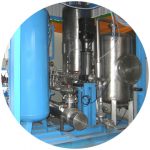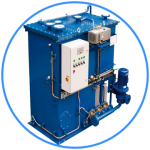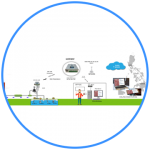Towards Green World

ADVANCED OXIDATION PROCESS
Advanced Oxidation Processes offers alternate treatment for pollutants in textile wastewaters, which commonly contains high concentrations of recalcitrant organic and inorganic chemicals and are characterised by high chemical oxygen demand (COD) and total organic carbon (TOC), high amounts of surfactants, dissolved solids, heavy metals and strong colour. AOPS processes are combination of ozone (O3), hydrogen peroxide (H2O2) and UV irradiation. These oxidants effectively decolorized dyes, however do not remove COD completely.
By properly combining ozone, hydrogen peroxide and UV different AOP techniques have been developed by us thus allowing to make choice the most appropriate for the specific problems. The efficiency of AOPs is compound specific, the final choice of the AOP system is to be made only after conducting Pilot test.
Known treatment method for the textile industry is Activated sludge process with physical and chemical processes. These traditional treatment methods require large space and are affected by wastewater flow and characteristic variations. But, either activated sludge process. Also other treatment technologies such as membrane processes, ion exchange, activated carbon adsorption etc. can only transfer pollutants from one phase to other phase rather than eliminating the pollutants from effluent body. The AOPs show specific advantages over conventional treatment alternatives because they can eliminate non-biodegradable organic components and avoid the need to dispose of residual sludge.

ELECTRO COAGULATION
Electrocoagulation (EC) has manybenefits : compatible for various types of Effluents, Easy to automate, Lower Cost of Operation, Lower Energy consumption, safety, and versatility. The technology can be successfully employed for treating waste water from having heavy metals, food, oil wastes, textile and dyes, organic matter from landfill leachate, suspended particles, chemical and mechanical polishing wastes, Coagulation of Ultrafine Particles,, phenolic waste, and refractory organic pollutants including lignin
Electrocoagulation operating conditions are mostly dependent on the chemistry of the aqueous medium, mainly conductivity and pH. Also other important characteristics are particle size, type of electrodes, retention time between plate, plate spacing and chemical constituent concentrations.
Advantages
- EC requires simple equipment and is easy to operate.
- Low operating cost. (iii)
- No moving Parts thus requires less maintenance.
- Does not require any chemicals and hence no possibility of secondary pollution
- Sludge formed is easily settable and easy to de-water, so low sludge generation
- Flocksformed are much largerand therefore, can be separated faster by filtration
- The Treated water is almost clear, colorless, odorless water with zero discharge
- Handles large variation in the waste streams with multiple contaminants.

HIGH PERFORMANCE MEDIA FILTERS
The High Performance Media Filter uses Unique Filtration Media, Garnet and Pebbles. These specially designed filtration system enables the filtration of water to 8-10 microns, Saves lot of water, reduces down time and energy required etc
Advantages
- Highly Efficient
- filters suspended solids up to 8-10 microns, making it far superior than conventional media filters that uses Sand as media, which filters only up to 30-40 microns. This reduces the replacement of downstream Cartridge filters, UF membranes, and RO membranes.
- Reduced backwash time leading to reduced waste water generated almost upto 80%
- Higher Up time due to lower backwash time
- Also reduces microbiological growth and odour formation
- 100% recyclable

WATER APPLICATION REMOTE MONITORING SYSTEM (WARM)
This monitoring and controlling system is developed in order to provide a customized solution to Water Treatment Plant. Data to be observed by the system are in the form of digital and analog. Digital data can be either Pump on/off condition, Valve on/off conditions, Hydraulic faults, Electrical faults or Pump faults.Analog data indicate properties such as water flow rates, water pressure, sump levels etc. A Programmable Logic Controller (PLC) is used to acquire and process all the data from analog and digital modules. Then through a communication processor, data is acquired by the server software over the wireless network. Data is stored at the server databases
- Alarm functions enable rapid identification of abnormalities.
- Reduces time required for periodic monitoring and patrolling of facilities.
- Systems easy to set up, minimizing engineering man hours.